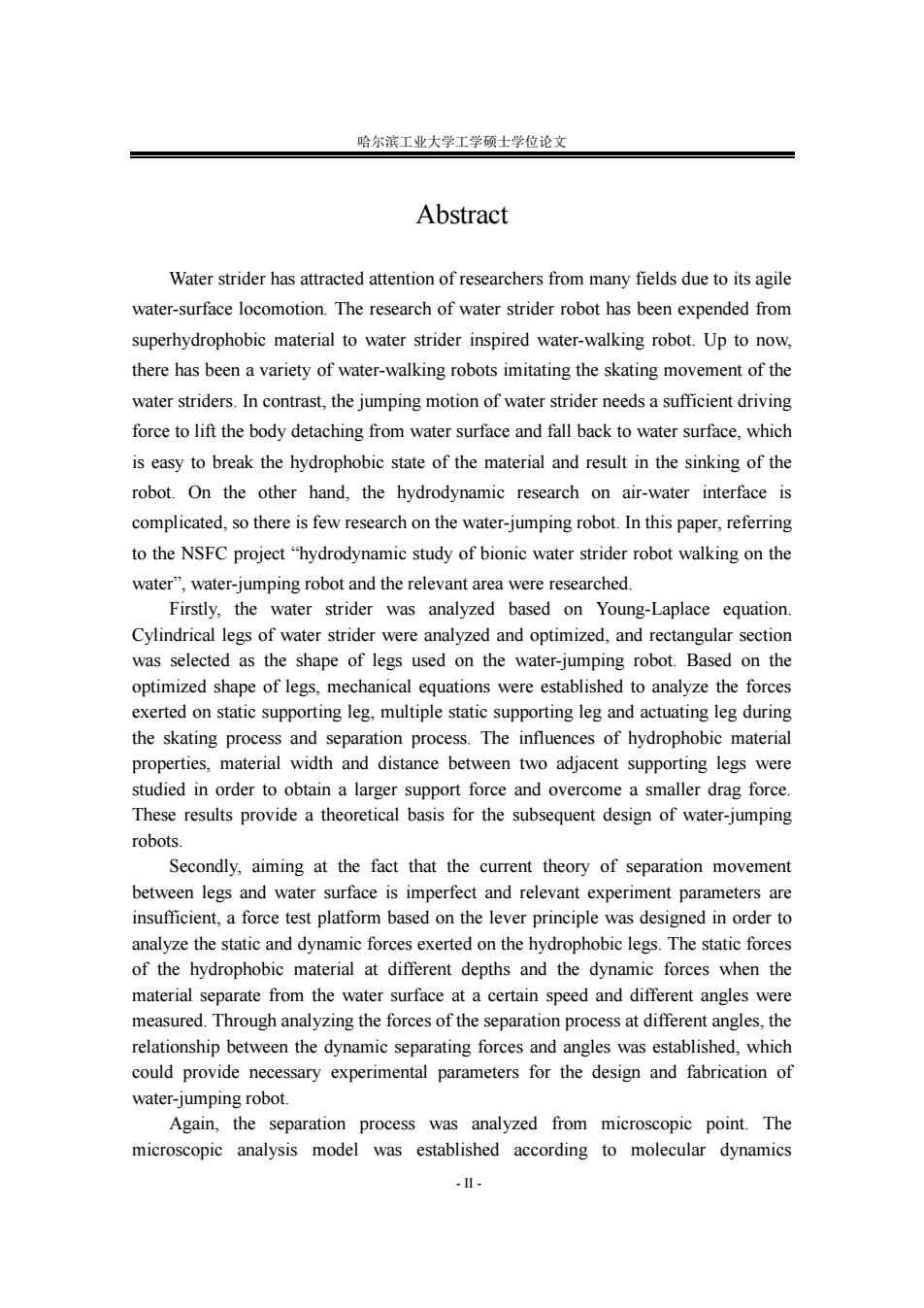正在加载图片...

哈尔滨工业大学工学硕士学位论文 Abstract Water strider has attracted attention of researchers from many fields due to its agile water-surface locomotion.The research of water strider robot has been expended from superhydrophobic material to water strider inspired water-walking robot.Up to now, there has been a variety of water-walking robots imitating the skating movement of the water striders.In contrast,the jumping motion of water strider needs a sufficient driving force to lift the body detaching from water surface and fall back to water surface,which is easy to break the hydrophobic state of the material and result in the sinking of the robot.On the other hand,the hydrodynamic research on air-water interface is complicated,so there is few research on the water-jumping robot.In this paper,referring to the NSFC project "hydrodynamic study of bionic water strider robot walking on the water",water-jumping robot and the relevant area were researched. Firstly,the water strider was analyzed based on Young-Laplace equation. Cylindrical legs of water strider were analyzed and optimized,and rectangular section was selected as the shape of legs used on the water-jumping robot.Based on the optimized shape of legs,mechanical equations were established to analyze the forces exerted on static supporting leg,multiple static supporting leg and actuating leg during the skating process and separation process.The influences of hydrophobic material properties,material width and distance between two adjacent supporting legs were studied in order to obtain a larger support force and overcome a smaller drag force. These results provide a theoretical basis for the subsequent design of water-jumping robots. Secondly,aiming at the fact that the current theory of separation movement between legs and water surface is imperfect and relevant experiment parameters are insufficient,a force test platform based on the lever principle was designed in order to analyze the static and dynamic forces exerted on the hydrophobic legs.The static forces of the hydrophobic material at different depths and the dynamic forces when the material separate from the water surface at a certain speed and different angles were measured.Through analyzing the forces of the separation process at different angles,the relationship between the dynamic separating forces and angles was established,which could provide necessary experimental parameters for the design and fabrication of water-jumping robot. Again,the separation process was analyzed from microscopic point.The microscopic analysis model was established according to molecular dynamics -Ⅱ-哈尔滨工业大学工学硕士学位论文 - II - Abstract Water strider has attracted attention of researchers from many fields due to its agile water-surface locomotion. The research of water strider robot has been expended from superhydrophobic material to water strider inspired water-walking robot. Up to now, there has been a variety of water-walking robots imitating the skating movement of the water striders. In contrast, the jumping motion of water strider needs a sufficient driving force to lift the body detaching from water surface and fall back to water surface, which is easy to break the hydrophobic state of the material and result in the sinking of the robot. On the other hand, the hydrodynamic research on air-water interface is complicated, so there is few research on the water-jumping robot. In this paper, referring to the NSFC project “hydrodynamic study of bionic water strider robot walking on the water”, water-jumping robot and the relevant area were researched. Firstly, the water strider was analyzed based on Young-Laplace equation. Cylindrical legs of water strider were analyzed and optimized, and rectangular section was selected as the shape of legs used on the water-jumping robot. Based on the optimized shape of legs, mechanical equations were established to analyze the forces exerted on static supporting leg, multiple static supporting leg and actuating leg during the skating process and separation process. The influences of hydrophobic material properties, material width and distance between two adjacent supporting legs were studied in order to obtain a larger support force and overcome a smaller drag force. These results provide a theoretical basis for the subsequent design of water-jumping robots. Secondly, aiming at the fact that the current theory of separation movement between legs and water surface is imperfect and relevant experiment parameters are insufficient, a force test platform based on the lever principle was designed in order to analyze the static and dynamic forces exerted on the hydrophobic legs. The static forces of the hydrophobic material at different depths and the dynamic forces when the material separate from the water surface at a certain speed and different angles were measured. Through analyzing the forces of the separation process at different angles, the relationship between the dynamic separating forces and angles was established, which could provide necessary experimental parameters for the design and fabrication of water-jumping robot. Again, the separation process was analyzed from microscopic point. The microscopic analysis model was established according to molecular dynamics